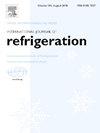Molecular dynamics study of the evaporation of R1233zd(E) and its isomers on Cu surface
IF 3.5
2区 工程技术
Q1 ENGINEERING, MECHANICAL
International Journal of Refrigeration-revue Internationale Du Froid
Pub Date : 2025-02-01
DOI:10.1016/j.ijrefrig.2024.12.019
引用次数: 0
Abstract
As a new alternative working fluid of heat pump, HFO-1233 has excellent environmental performance and theoretical cycle characteristics. However, the differences in physicochemical properties between its isomers can affect the interfacial evaporation characteristics, which is of great significance for further screening of the working fluid. In this paper, the evaporation behavior of liquid films of R1233zd(E), R1233zd(Z) and R1233xf on Cu surface at 335 K was simulated by molecular dynamics method. The results show that among the three working fluids, R1233xf has the smallest Kapitza thermal resistance at the vapor-liquid interface, which is only 0.38 × 10−7 m2⋅K⋅W−1. Moreover, the surface tension and liquid interaction energy of R1233xf are the smallest, and the self-diffusion coefficient is the largest, which will accelerate the escape of R1233xf at the vapor-liquid interface. The resulting evaporation rate and heat flux are R1233xf > R1233zd(E) > R1233zd(Z). At steady state, the evaporation rate of R1233xf reaches 1240 kg⋅m−2⋅s−1, which is 1.38 times that of R1233zd(Z). Finally, the solid-liquid interaction strength of the three working fluids in the solid-like layer was studied by the solid-liquid interaction model, and it was found that R1233xf still had the smallest solid-liquid interaction force. The results explain the interfacial phase change mechanism of working fluids from the molecular-scale, providing insights for the selection of working fluids and the design of heat exchangers in high-temperature heat pumps.
求助全文
约1分钟内获得全文
求助全文
来源期刊
CiteScore
7.30
自引率
12.80%
发文量
363
审稿时长
3.7 months
期刊介绍:
The International Journal of Refrigeration is published for the International Institute of Refrigeration (IIR) by Elsevier. It is essential reading for all those wishing to keep abreast of research and industrial news in refrigeration, air conditioning and associated fields. This is particularly important in these times of rapid introduction of alternative refrigerants and the emergence of new technology. The journal has published special issues on alternative refrigerants and novel topics in the field of boiling, condensation, heat pumps, food refrigeration, carbon dioxide, ammonia, hydrocarbons, magnetic refrigeration at room temperature, sorptive cooling, phase change materials and slurries, ejector technology, compressors, and solar cooling.
As well as original research papers the International Journal of Refrigeration also includes review articles, papers presented at IIR conferences, short reports and letters describing preliminary results and experimental details, and letters to the Editor on recent areas of discussion and controversy. Other features include forthcoming events, conference reports and book reviews.
Papers are published in either English or French with the IIR news section in both languages.

 求助内容:
求助内容: 应助结果提醒方式:
应助结果提醒方式:


